Study nut production, development and harvest
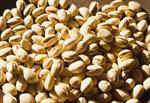 Learn with our Exceptional tutor support
Learn with our Exceptional tutor support- Our horticulture faculty includes a dozen university trained professionals most with decades of industry experience.
- You have unlimited access to tutors over the phone or email.
DURATION
The course requires 100 hours of study.
START DATE
Start the course at any time - to suit YOU.
COURSE STRUCTURE AND CONTENT
There are 8 lessons as follows:
1. Introduction
- What is a nut.
- Classification of edible nuts.
- Nature and scope of nut production.
- System of plant classification.
- Plant pronunciation.
- More Resources.
2. The Most Commonly Grown Varieties
- Introduction to nuts.
- Quick guide to choosing nut trees to grow.
- Terminology.
- Review culture of different commonly grown varieties of nuts:
- Almond.
- American Hazelnut.
- Cashew.
- Peanut.
- Walnut.
- Macadamia.
3. Culture of Nuts
- Site selection and management.
- Site characteristics.
- Climate.
- Pest and disease, weeds, water and other considerations.
- Soils and Nutrition management.
- Water management.
- Planting, staking, mulching, watering, pest & disease, feeding, pruning, protection from wind, salt, air, etc.
4. Less Common Nuts
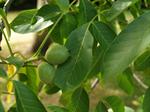 Culture of different less commonly grown varieties of nuts.
Culture of different less commonly grown varieties of nuts.- Corylus species (Hazels).
- Pecan.
- Pistachio.
- Pine Nuts.
- Chestnuts.
- Filberts.
- Beech, Oak, Sunflower, Pili Nut, Acacia etc.
5. Propagation
- Seed propagation.
- Cuttings.
- Grafting.
- Layering.
- Hardening off young plants.
- How to propagate a range of specific nut species/cultivars.
6. Harvest & Post-harvest of Nuts
- Techniques for harvesting a nut crop.
- Cleaning, Cracking and Shelling.
- Drying.
- Storage.
- Treatment of specific types of nuts:
- Almonds.
- Chestnuts.
- Pine Nuts.
- Walnuts.
- Pistachios.
- Cashews.
7. Marketing Nuts
- Scope and nature of marketing.
- Options for marketing nuts.
- The marketing process.
- Understanding supply and demand with nuts.
- Market research.
- Uses for nuts -the different products that might be sold:
- Food products, processed or unprocessed.
- Mulch.
- Craft products.
- Timber.
8. Risk Management
- Workplace Health and Safety in the nut industry.
- Risk Assessment (Health, economic, environmental, etc).
- Managing risk.
Plus - Special Assignment - Where you investigate a nut species or type of your own choosing.
COURSE AIMS
- Identify different nut crop varieties.
- Determine the cultivation practices appropriate to a range of different nut crops.
- Determine how to propagate a range of different nut plants.
- Determine appropriate techniques for harvesting a nut crop.
- Specify an appropriate post-harvest treatment for a nut crop.
- Develop marketing strategies for nuts.
WHAT THE COURSE COVERS
Here are just some of the things you will be doing:
- Distinguish between common and scientific perceptions of the term nut.
- Compare the botanical characteristics of the fruits from different nut genera.
- Describe the botanical classification different species of nut plants, including where appropriate, botanical interrelationships.
- Prepare a plant collection of nut varieties, including the following details on each plant:
-
- Plant names (Common and scientific).
- A photo, illustration or pressed specimen.
- Cultural details.
- Harvest & Post-harvest.
- Uses (eg. valuable products).
-
Develop a resource file of different information relevant to the nut growing industry, including:
- Suppliers of nut plants.
- Trade or grower associations.
- Publications.
-
Perform simple tests on different soils to determine:
- Soil type.
- pH.
- Drainage.
- Water holding capacity.
- Evaluate three different soils to determine nut varieties suitable for growing in each.
-
Explain soil management requirements for different nut varieties, including:
- Nutrition.
- Soil structure.
- Physical attributes.
- Explain the control of different pests and diseases on different nut varieties.
-
Develop guidelines for the culture of a specified variety of nut, in your locality, including:
- Watering.
- Weed control.
- Soil management.
- Fertilising.
- Pest control.
- Disease control.
- Prepare a twelve month plan for cultural practices on a specified nut plantation.
-
Explain different methods of propagating five different nut species, including:
- Seed.
- Grafting.
- Layering.
- Cuttings.
- Determine propagation methods for different nut species, including where applicable, rootstock variety names.
- Demonstrate how to prepare cuttings for different nut species.
- Demonstrate different types of grafts, suitable for propagating nut varieties.
- Determine seed germination procedures for different nut genera.
- Prepare a production schedule, for nursery production of one type of nut.
- Propagate different nut plant varieties.
- Explain the operation of a mechanical harvester which can be used for nuts.
- Determine when to harvest different specified nut species.
- Compare the efficiency of different techniques for harvesting nuts.
- Describe different storage techniques for a nut variety.
- Determine the optimum environmental conditions for the storage of different nut species.
- Evaluate three different samples of nuts, which have been stored using different techniques.
- Determine the commercial processing techniques used for nuts.
- Explain post-harvest handling of a specified nut species.
- Determine different ways in which nuts can be consumed.
-
Compare different ways nuts are packaged for retailing, referring to:
- Physiological impact on the nut.
- Cost of packaging.
- Presentation.
- Explain the marketing of different specified nut products, in your locality.
- Develop a marketing plan for a nut product.
More than Just Spanish Chestnuts
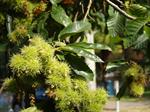 Most people are familiar with the Spanish Chestnut (Castanea sativa); but there are other edible species of Castanea as well; also known as Chestnuts.
Most people are familiar with the Spanish Chestnut (Castanea sativa); but there are other edible species of Castanea as well; also known as Chestnuts.
Chestnuts need good rainfall and cooler climates in mountain areas, shelter form the wind and deep well drained soils. pH 5.5 to 6. Avoid frost pockets if possible. Heavy pruning of young trees can delay the production of nuts. They are generally self-sterile and require more than one variety nearby for cross pollination. Most likely pollinated both by insects and wind. In areas below 75cm annual rainfall young trees will require irrigation.
They are affected by hot summer temperatures.
Chestnuts are related to oak, sharing the same family; Fagaceae. Japan and Italy are the largest producers of these nuts. Long leaves with coarse, toothed margins and hairs on the under surface.
In the past blight has been a serious problem in America, Europe and Asia; but this has been largely controlled by selecting and using resistant varieties. Not very drought tolerant when young, but has more tolerance once established.
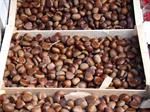 Fruit ripens over a period of time through autumn. Nuts have been traditionally harvested from the ground after they fall, but this is labour intensive and leaves nuts prone to being eaten by animals. It is also possible to remove nuts while still attached to or inside fruits (burs); by knocking them off the trees with sticks. Wear gloves when handling burs –they can be prickly. Nuts are beaten out of the husks and marketed at once or else prepared for dry storage. Once the nut has dried, to store, pack in alternate layers of dry sand in a cool dry position. They will store this way for several months.
Fruit ripens over a period of time through autumn. Nuts have been traditionally harvested from the ground after they fall, but this is labour intensive and leaves nuts prone to being eaten by animals. It is also possible to remove nuts while still attached to or inside fruits (burs); by knocking them off the trees with sticks. Wear gloves when handling burs –they can be prickly. Nuts are beaten out of the husks and marketed at once or else prepared for dry storage. Once the nut has dried, to store, pack in alternate layers of dry sand in a cool dry position. They will store this way for several months.
There are two forms of Spanish Chestnut (C. sativa):
- Marrons –a single chestnut inside a spiky husk. These are sweeter and more flavoursome. These nuts are often preserved by coating in sugar (which are called Marron Glace).
- Chataignes –have 2 or 3 smaller nuts inside a husk.
Other Chestnut Species include:
Japanese Chestnut (Castanea crenata) To 9 metres tall, indigenous to Japan and Korea; will grow in full sun or semi shade. Can be shorter lived than other species, though there are exceptions. Prefers a well drained acidic soil, but tolerates low nutrition. Nuts are not very flavoursome, but can be eaten raw or cooked and are sometimes used as a potato substitute. They can have an astringent taste, which will be removed by boiling in salty water.
Chinese Chestnut (Castanea mollissima) –To 27 metres tall and 20 metres diameter; but often shorter; green leaves with a softer downy surface on the under side. Produces a superior tasting nut, grown as a commercial crop in many places including parts of the USA. Trees have similar climatic and soil requirements to a peach tree. These can be attacked by a canker if the tree is weak, but generally canker disease is not a serious problem.
American Chestnut (Castanea dentata) –This species was devastated by disease that attacks the bark causing cankers (a blight) in the ealy 20th century; and it’s ongoing susceptibility to the disease makes it undesirable for cultivation, despite the culinary value of the nuts. Long leaves with coarse, toothed margins similar to C. sativa, but no hairs on the under surface.
Expand Your Appreciation of Nuts
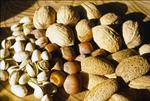 There are hundreds of different types of edible nuts and within many of these groups, you can find lots of different cultivars or species, just as seen above with chestnuts.
There are hundreds of different types of edible nuts and within many of these groups, you can find lots of different cultivars or species, just as seen above with chestnuts.
By studying this course, you will expand your appreciation of what is possible. Knowing a greater diversity of nuts to grow and use, will help some to plan the development of a farm that can offer a very unique product. For others it will provide you with an opportunity to become more self sufficient, and to diversify your diet.
WHAT NEXT?
Register to Study - Go to “It’s Easy to Enrol” box at the top of the page and you can enrol now.
or
Get Advice – Email us at info@acsedu.co.uk OR
Use our FREE COUNSELLING SERVICE to contact a tutor
CLICK TO CONTACT US